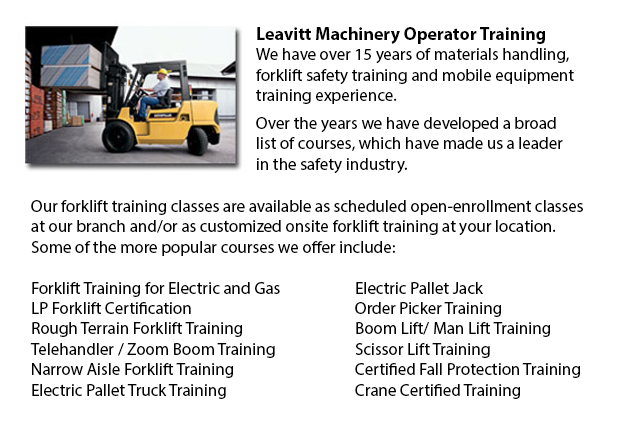
Sudbury Forklift Training Schools - What Our Forklift Training Prgrams Can Provide Your Business
If you are looking for work as an operator of a forklift, our regulatory-compliant forklift training Schools offer exceptional instruction in numerous types and styles of lift trucks, lessons on pre-shift check, fuel kinds and handling of fuels, and safe utilization of a lift truck. Practical, hands-on training helps participants in acquiring fundamental operational skills. Program content consists of current regulations governing the operation of lift trucks. Our proven forklift Schools are intended to offer training on these kinds of trucks: counterbalanced forklift, powered pallet trucks and narrow isle forklift.
Do not lower or raise the fork when the forklift is traveling. A load must not extend over the backrest because of the danger of the load sliding back toward the operator. Inspect for overhead obstructions and ensure there is sufficient clearance prior to lifting a load. Stay away from overhead power lines. Once the load is lifted straight up, tilt it back slightly.
The lift truck is less steady when a load is in a raised position. Ensure that no body ever walks beneath the elevated fork. The operator should never leave the forklift while the load is raised.
While handling pallets, forks must be high and level enough to go into the pallet and extend all the way below the load. The fork's width must provide even distribution of weight.
Prior to unloading or loading the truck, set the brakes and chock the wheels. Floors must be strong enough to support the weight of the forklift and the load combined. Fixed jacks could be installed to be able to support a semi-trailer which is not coupled to a tractor. The height of the entrance door should clear the forklift height by a minimum of 5 cm. Mark edges of docks, rail cars or ramps and avoid them.
-
Wheel and Track Loader Training in Sudbury
Lift trucks are obtainable in several different models that have different load capacities. The majority of average forklifts used in warehouse environment have load capacities of 1-5 tons. Bigger scale units are utilized for heavier loads, like for... More -
Sudbury Aerial Lift Certification
Sudbury Aerial Lift Certification - Aerial Lift Certification is for individuals who requires an in-depth understanding of aerial lift safety. Inspectors and operators, supervisors, maintenance workers and construction craftsmen must perform a traini... More -
Sudbury Forklift Certification Schools
Sudbury Forklift Certification Schools - Within North America, forklift certification is mandatory, making forklift training programs necessary for both the company and their employees working as forklift operators. Forklift training focuses on healt... More -
Sudbury Boom Lift Operator Training
Sudbury Boom Lift Operator Training - A cherry picker refers to a type of aerial work platform. Cherry pickers include a platform or bucket at the end of a hydraulic lifting system. The device is likewise called a man lift, boom lift, basket crane or... More -
Sudbury Telehandler Certification
Sudbury Telehandler Certification - Telehandler certification programs are both for operators who have some experience driving a standard forklift and for those with no experience. The real-world training offered by these courses produces graduates w... More -
Operator Safety Training, Re-Qualification Training, In-House Instructor Training in Sudbury
Lift trucks are utilized in just about all industrial construction sites and in warehouse operations and in boat yards. The reach feature of a lift truck is a vital component used in several applications like for example when a shelving system is bei... More -
Crane / Overhead Crane / Self-Erect Crane / Truck Mounted Crane / Hydraulic Cranes Training in Sudbury
Bridge cranes or overhead cranes are a type of industrial material handling crane making use of a line and hook apparatus which runs on a horizontal beam running along two widely separated rails. Lots of overhead cranes could be seen in a long factor... More -
Sudbury Forklift Safety Training
Sudbury Forklift Safety Training - Anyone who wants to operate a lift truck should take a forklift safety training course in order to become a certified forklift truck operator. There are a variety of ways to obtain forklift training. Programs are pr... More

Forklift Certification Sudbury
TOLL FREE: 1-888-254-6157
Sudbury, Ontario
forkliftcertificationsudbury.com
Email Us
About Us


